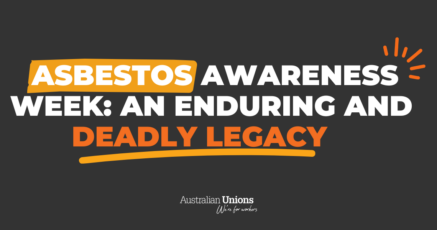As vaccination rates creep closer to the National Cabinet thresholds for economic reopening in lockdown states, many workplaces are preparing to expand their operations in a new context, where vaccination rates make movement more possible, but where viral transmission still poses health and safety risks. While existing health and safety regulations and practices have been consistently adapted throughout the pandemic, this transitional time for the economy necessitates wider scale thinking about what safe working practices will look like, and how they can be achieved, in the face of this reopening.
The first priority in these reassessments must necessarily be reducing contagion and exposure, as even where vaccination rates are high, reducing and limiting transmission will remain crucial to ensure that those who are most clinically vulnerable are protected. This has been the focus of the recent ACTU campaign Keeping Work Covid Free and Safe, which emphasises two priority areas for workplaces during reopening: improving ventilation and distancing as a hygiene measure. These priorities work alongside wider measures which work alongside each other to minimise risk, including use of appropriate PPE, vaccination and testing. These collected resources for workplaces build on established OHS tools and approaches to help translate and update workplace safety for this stage of reopening.
In addition to the immediate risks of viral contagion, it will be crucial over coming weeks and months to consider and address the workplace health and safety risks which the pandemic has posed more broadly. This includes recognising the accumulated risks that workers have faced over the course of the past two years, along with new and ongoing ones. Those in frontline work, especially in the healthcare sector, have been subject to significant mental health risks, along with other physical health risks in addition to the risk of COVID-19 infection. These risks have been sustained over a long period of time, and exacerbated by the way in which healthcare workers are experiencing the same long waiting lists and limited access which characterise the underfunded public health sector as a whole. Frontline workers in retail, logistics, and food service, who have borne the impact of Australia’s pivot to more delivery-focused consumption, have also experience physical and psycho-social hazards associated with their “essential worker” roles, and exacerbated by the high rates of insecure workers in these industries.
For those industries and roles which have involved remote working, the health and safety impacts of isolation, the stressors of juggling care and work responsibilities, and the physical impacts of extended screen time requirements and the increasingly permeable boundaries between home and work, are also factors which will need attention in workplace transitions. The health and safety impacts of other environmental extremes and hazards, from air quality to heat stress, also intersect with many of the physical and psychological hazards of the pandemic, and these latter risks are poised to continue to escalate.
Whether in addressing the starting points of viral transmission, or in considering the broader health and safety impact of the pandemic, it will be crucial to for workplaces, and for workplace safety legislation more broadly, to maintain the principle of ensuring safety for the most vulnerable and high risk workers. In some media coverage there has been a tendency to assume that people who are in higher risk factor categories for COVID-19, including those who once classified as category 1a or 1b for vaccine eligibility, are not also workers themselves. These inaccurate stereotypes have been partly driven by clumsy political messaging: for example, disabled workers and workers with chronic illnesses have been caught between inconsistent and changing eligibility definitions throughout the vaccination rollout, leading to delayed access to vaccination despite being more vulnerable to COVID-19. Ensuring that high standards of ventilation, distancing, and hygiene practices are maintained as part of standard workplace health and safety will therefore ensure that workplaces are able to be more inclusive in supporting higher risk individuals at work. This approach demonstrates how the concept of “touch one, touch all” is integral to thinking about workplace safety, where the foundation of safety is recognising our interconnected needs, and that supporting those most vulnerable strengthens us all.
There will be health and safety impacts which vary by sector and region, but learning from the experiences of workplaces in COVID hotspots and higher risk industries is crucial to ensure stronger supports for workers’ health and safety across the board. Now, as the Australian economy prepares to move towards a vaccinated open economy, rethinking workplace health and safety in a broader sense will help ensure that the burdens of these transformations to working life are shared fairly.







SHARE:
Reassessing workplace safety is crucial to economic recovery